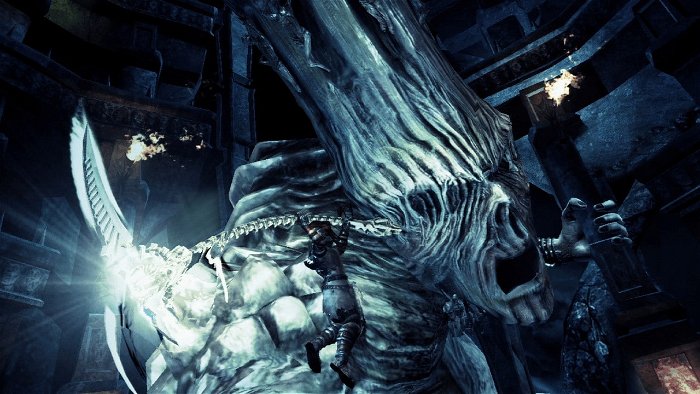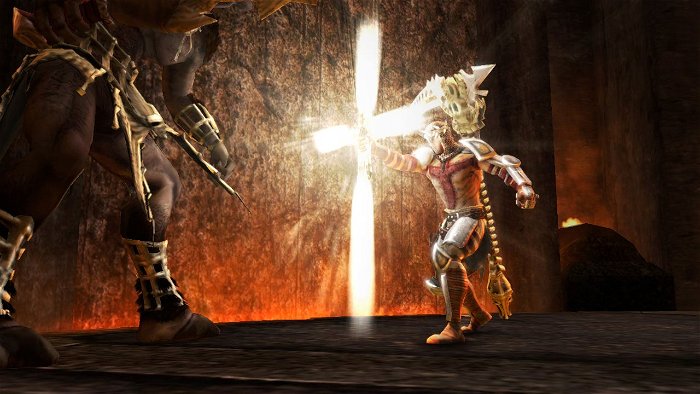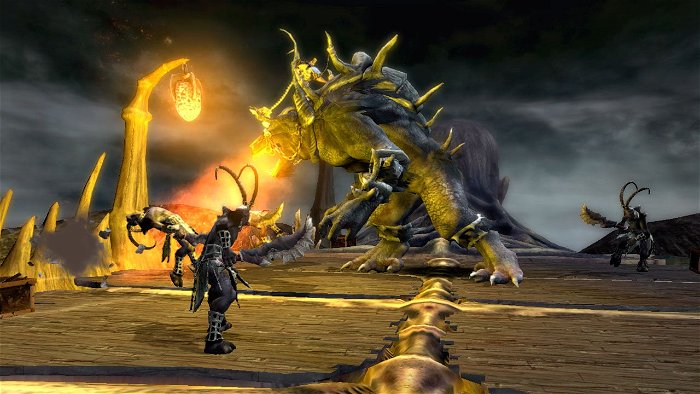Few games have grabbed more recent headlines than Visceral Games’ Dante’s Inferno, and with good reason.
It’s one of the first major adaptations of a classical literary work and could have a significant impact on the future of the industry. Yet at its core Dante’s Inferno is still a game, and not all the press has been positive. The game has high design standards, but many critics have accused the game of being overly derivative and reviewer scores have reflected these complaints.
We asked Jonathan Knight some questions about the game’s reception and design, and he took the opportunity to respond to the game’s critics and to elaborate on the creative process. Here, he shares his thoughts on innovation, multiplayer, and phonies, and finally puts one out-of-control rumour to rest.

Dante’s Inferno is one of the first games bold enough to engage with a canonical literary text. How does the development of a game with a history differ from the development of an original work like 2008’s Dead Space?
Jonathan Knight: Working from The Divine Comedy gave us a strong vision and structure early in the process, solidified what the levels would be, who the main characters would be, and so forth. It allowed us to make a lot of conceptual decisions very quickly.
Some members of the development team have backgrounds in fields other than gaming. How did this influence the creative process of game development?
Jonathan Knight: It’s not unusual for game developers to have backgrounds in different fields; the industry itself is pretty young. My training in classical dramatic literature gave me an appreciation for literature that may have drawn me to formulize this project, but otherwise, it didn’t have an unusual influence. The team is full of incredibly talented and creative people from all walks of life.
Should gaming be more receptive to outsider perspectives? How might the industry as a whole benefit from the input of more mainstream critics and collaborators?
Jonathan Knight: We’ve had input from a pretty wide variety of sources, from the loudest user comments on Kotaku, to the front page of the New York Times. It doesn’t get broader than that!

A lot has been made of the similarities between Dante’s Inferno and God of War, particularly in terms of game play. Is this a fair criticism in an industry rife with imitation? How do you respond to critics demanding more ‘originality’?
Jonathan Knight: We don’t feel that the volume and intensity of that criticism was particularly fair, no, because it resulted in an overall metacritic score that doesn’t truly represent the quality of the assets that were made, and of the experience that was delivered. The game is incredibly polished, high-end, and high-performing. The production values are amazing. And the core combat and controls feel as good as the best game in the genre.
I agree that 90+ rated games should deliver originality (although there are some that don’t and still score that high, particularly sequels of established games). But our game is not a 75. And it does stand on its own, while obviously being squarely in the melee action genre. Unfortunately, a lot of people decided that the God of War comparison would form the basis of their review, and that decision was made a long time ago, and carries a great deal of emotion with it. But yes, there are plenty of examples of games working side-by-side in the same genre, and the irony is that we probably have more in common with Devil May Cry than God of War.
In other media, it is common practice to recycle old ideas in order to make something new. Shakespeare, for instance, did not tell original stories. He simply told the same stories better. Should the same philosophy apply to game design, insofar as good ideas should be reused if it will lead to better games for consumers?
Jonathan Knight: It is happening now, and has been for some time. This doesn’t mean that innovations aren’t important, and that games shouldn’t break down barriers, invent new genres, combine genres, leverage new technologies in new ways, etc. But there has always been room for games to borrow from each other, and give their own spin on it.
Let’s flip the question around. What is the most original game play device in Dante’s Inferno? Is there something specific that future developers should take note of when making similar games?

In terms of the combat system and the mechanics, the most original device is called Righteousness, and it is the player’s ability to choose to either Punish or Absolve an enemy in the split second before they finish them off. This also applies to the Damned found throughout the game. This moral choice over the destiny of their souls feeds a Holy vs. Unholy meta-system that defines Dante’s powers and abilities over time. Another very original feature is coming in the form of a download in April called Trials of St. Lucia. It will offer a custom combat scenario editor, a second playable character, and online cooperative play.
Gaming, for better or worse, is commonly viewed as an adolescent medium. Did you ever feel pressured to ‘dumb it down’ in order to make the game more fun or to give it a broader, more traditional gaming appeal?
Jonathan Knight: We always wanted the game to be fun; that was the most important thing to us.
Many of the cut scenes in Dante’s Inferno have a very retro aesthetic, opting for effective 2-D animation instead fully rendered CGI. What led to this artistic decision? Did the relaxation of enforced graphical demands give you more freedom to create unique images for Dante’s Inferno?
It was a different way of expressing the raw emotion of Dante’s memories of his past sins. It also was part of the overall conceit of the tapestry sewn into his chest—the idea that he carries these scenes with him, and we can zoom into them at any time, and they come to life, and tell the story of those heinous crimes. I liked how Tarantino used 2D animation to tell one of the origin stories in Kill Bill, and there are other examples like this that inspired us.
Lately, it seems that every new game must have some kind of online multiplayer component. Is this a healthy trend for the industry, or do you foresee adverse consequences that other developers might be ignoring?
Jonathan Knight: It’s a very healthy trend, in that gamers are more and more connected, and are expecting extended experiences with the games they buy. What’s unhealthy is when a development team feels forced to tack on an online mode that doesn’t really work with the core nature of the game, and this ends up costing a lot of time and money, and then people don’t really care about it.
Given that your games feature strong single-player campaigns, did you ever feel pressured to incorporate more multiplayer components into Dante’s Inferno?
Jonathan Knight: We have a very exciting online and multiplayer feature coming in April, called Trials of St. Lucia.
Since Dante’s Inferno ends with a ‘To Be Continued,’ it seems that we can expect more from this franchise in the future. Would potential sequels adapt the other two parts of the Divine Comedy, or does your Dante now stand apart as a game with its own characters and iconography?

We’re not ready to talk about sequels at this point in time; the team is focused on the exciting downloadable content coming in the next couple of months.
In the wake of Dante’s Inferno, will we see more developers mining English syllabi for inspiration? What are some of the pitfalls that the developers of The Catcher in the Rye: The Game might have to avoid?
Watch out for the phonies 🙂
Will there ever come a time when students study video games alongside books or movies in classrooms? What will it take to push gaming into that academic realm, and how will Dante’s Inferno influence the discussion?
I’m sure the time will come. One challenge is the platform and the technology; games don’t preserve as easily for playback and study as other mediums like books and movies. I think Dante’s Inferno has one foot in the past—as a high-action button-mashing thrill ride of a video game—and one foot in the future—as an adaptation of one of the greatest works of literature. We took the arrows in the back, so to speak, and there was a lot of debate about it. This will surely help the medium going forward.
What book adaptations would you be the most excited to experience in game form?
Jonathan Knight: I better not say 🙂
Finally, is there any truth to the rumor that a Macbeth game could be in the works? And if so, when can I preorder it?
Jonathan Knight: No, no truth to that rumor, it simply came from me answering the previous question a few too many times 🙂



